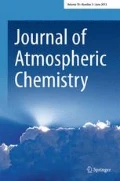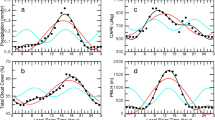Abstract
Record high near-surface ozone concentrations at two elevated sites (Chaumont, 1140 m asl, and Rigi, 1030 m asl) in Switzerland were observed simultaneously with extremely low total ozone during a fair weather period in mid-February 1993. An analysis of ozone, temperature, humidity, and wind profiles suggests that the surface ozone peaks were most possibly generated within the region in a layer between about 1000 and 1500 m asl. Mean diurnal cycles of ozone concentration during the period shows a strong increase from late morning to late afternoon at Chaumont and at the same time a decrease at the high alpine site Jungfraujoch (3580 m asl). The different diurnal ozone cycles can both be explained photochemically by taking into account the large difference in NOx concentrations (about two orders of magnitude) between the sites. Photochemical processes are also indicated by the diurnal cycles of NO2 and NO concentration. As a strong photochemical activity is not expected in mid-February at 47°N, we hypothesize that the extremely low total ozone played a role. Total ozone controls the amount of UV-B radiation reaching the troposphere and thus influences photochemical processes. Using a radiation model, we calculated an increase in ozone photolysis at Chaumont and Jungfraujoch of 73% and 83%, respectively, on the day with the lowest total ozone (243 DU) compared to average February conditions (335 DU). It is suggested that total ozone changes have the potential to stimulate photochemistry sufficiently to produce the observed surface ozone peaks at Chaumont and Rigi of 61 and 64 ppbv, respectively. A fog layer just below Chaumont during these days probably also influenced photochemistry, but on a smaller spatial scale. Our empirical results on the influence of changing UV radiation on tropospheric photochemistry are in close agreement with model studies of other groups. Although this case study represents unique conditions, a distinct anticorrelation between near-surface ozone at Chaumont and total ozone also appears in other years (1992–1997) when selecting fair weather days in mid-February. However, other influences cannot be excluded. The selected days provide evidence of a significant photochemical source of ozone in the mid-latitude lower troposphere in late winter.
Similar content being viewed by others
References
Bekki, S., Law, K. S., and Pyle, J. A., 1994: Effect of ozone depletion on atmospheric CH4 and CO concentrations, Nature 371, 595-597.
Bojkov, R. D., Zerefos, C. S., Balis, D. S., Ziomas, I. C., and Bais, A. F., 1993: Record low total ozone during Northern winters 1992 and 1993, Geophys. Res. Lett. 20, 1351-1354.
Brönnimann, S., 1998: Early spring ozone episodes: occurrence and case study, Phys. Chem. Earth (submitted).
Brönnimann, S. and Neu, U., 1997: Weekend-weekday differences of near-surface ozone concentrations in Switzerland for different meteorological conditions, Atmos. Environ. 31, 1127-1135.
Brönnimann, S., Neu, U., and Wanner, H., 1998: Correlations between total ozone and near-surface ozone at mountain sites in Switzerland in late winter, in P. M. Borrell and P. Borrell (eds), Proceedings of EUROTRAC Symposium '98, Southampton (in press).
Carpenter, L. J., Monks, P. S., Bandy, B. J., Penkett, S. A., Galbally, I. E., and Meyer, C. P., 1997: A study of peroxy radicals and ozone photochemistry at coastal sites in the Northern and Southern Hemispheres, J. Geophys. Res. 102, 25417-25427.
Davies, T. D. and Schüpbach, E., 1994: Episodes of high ozone concentrations at the earth's surface resulting from transport down from the upper troposphere/lower stratosphere: A review and case studies, Atmos. Environ. 28, 53-68.
DeMore, W. B., Sander, S. P., Golden, D. M., Hampson, R. F., Kurylo, M. J., Howard, C. J., Ravishankara, A. R., Kolb, C. E., and Molina, M. J., 1997: Chemical Kinetics and Photochemical Data for Use in Stratospheric Modeling, Evaluation Number 12,JPL Publication 97-4, Jet Propulsion Laboratory, Pasadena, California.
Elterman, L., 1968: UV, Visible and IR Attenuation to 50 km,Report AFCRL 68-1053, Air Force Cambridge Research Laboratories, Bedford, Massachusetts.
EMPA, 1994: Technischer Bericht zum Nationalen Beobachtungsnetz für Luftfremdstoffe (NABEL) 1994, Dübendorf.
Fuglestvedt, J. S., Jonson, J. E., and Isaksen, I. S. A., 1994: Effects of reductions in stratospheric ozone on tropospheric chemistry through changes in photolysis rates, Tellus 46B, 172-192.
Jacob, D. J., Horowitz, L. W., Munger, J. W., Heikes, B. G., Dickerson, R. R., Artz, R. S., and Keene, W. C., 1995: Seasonal transition from NOx-to hydrocarbon-limited conditions for ozone production over the eastern United States in September, J. Geophys. Res. 100, 9315-9324.
Kleinman, L. I., 1991: Seasonal dependence of boundary layer peroxide concentration: The low and high NOx regimes, J. Geophys. Res. 96, 20721-20733.
Krol, M. C. and vanWeele, M., 1997: Implications of variations in photodissociation rates for global tropospheric chemistry, Atmos. Environ. 31, 1257-1273.
Krol, M. C., van Leeuwen, P. J., and Lelieveld, J., 1998: Global OH trend inferred from methylchloroform measurements, J. Geophys. Res. 103, 10697-10711.
Krüger, B. C., Martilli, A., and Kübler, J., 1997: Effects of the total ozone column on tropospheric chemistry, Ann. Geophys. 15,Suppl. II, C545.
Lelieveld, J. and Crutzen, P. J., 1991: The role of clouds in tropospheric photochemistry, J. Atmos. Chem. 12, 229-267.
Liu, S. C. and Trainer, M., 1988: Response of the tropospheric ozone and odd hydrogen radicals to column ozone change, J. Atmos. Chem. 6, 221-233.
Madronich, S. and Granier, C., 1992: Impact of recent total ozone changes on tropospheric ozone photodissociation, hydroxyl radicals, and methane trends, Geophys. Res. Lett. 19, 465-467.
Madronich, S., Zeng, J., and Stamnes, K., 1997: Tropospheric ultraviolet-visible radiation model, Version 3.9a, February 1997.
Ruggaber, A., Dlugi, R., and Nakajima, T., 1994: Modelling radiation quantities and photolysis frequencies in the troposphere, J. Atmos. Chem. 18, 171-210.
Schnell, R. C., Liu, S. C., Oltmans, S. J., Stone, R. S., Hofmann, D. J., Dutton, E. G., Deshler, T., Sturges, W. T., Harder, J. W., Sewell, S. D., Trainer, M., and Harris, J. M., 1991: Decrease of summer tropospheric ozone concentrations in Antarctica, Nature 351, 726-729.
Shetter, R. E., Cantrell, C. A., Lantz, K. O., Flocke, S. J., Orlando, J. J., Tyndall, G. S., Gilpin, T. M., Fischer, C. A., Madronich, S. A., and Calvert, J. G., 1996: Actinometric and radiometric measurements and modeling of the photolysis rate coefficient of ozone to O(1 D) during Mauna Loa Observatory Photochemistry Experiment 2, J. Geophys. Res. 101, 14631-14641.
Staehelin, J. and Schmid, W., 1991: Trend analysis of tropospheric ozone concentrations utilising the 20-year data set of ozone balloon soundings over Payerne (Switzerland), Atmos. Environ. 25A, 1739-1749.
Stolarski, R., Bojkov, R., Bishop, L., Zerefos, C., Staehelin, J., and Zawodny, J., 1994: Measured trends in stratospheric ozone, Science 256, 342-349.
Taalas, P., Damski, J., Kyrö, E., Ginzburg, M., and Talamoni, G., 1997: Effect of stratospheric ozone variations on UV radiation and on tropospheric ozone at high latitudes, J. Geophys. Res. 102 , D1, 1533-1539.
Thompson, A. M., Stewart, R. W., Owens, M. A. and Herwehe, J. A., 1989: Sensitivity of tropospheric oxidants to global chemical and climate change, Atmos. Environ. 23, 519-532.
United Kingdom Photochemical Oxidants Review Group, 1997: Ozone in the United Kingdom. Fourth Report of the Photochemical Oxidants Review Group, London, ISBN 1-870393-30-9.
Vaughan, G. and Price, J. D., 1991: On the relation between total ozone and meteorology, Quart. J. R. Met. Soc. 117, 1281-1298.
Wege, K. and Claude, H., 1997: Über Zusammenhänge zwischen stratosphärischem Ozon und meteorologischen Parametern mit Folgerungen für die Zeiträume nach den Ausbrüchen von El Chichon und Pinatubo, Meteorol. Z., N. F. 6, 73-87.
Wunderli, S. and Gehrig, R., 1991: Influence of temperature on formation and stability of surface PAN and ozone. A two year field study in Switzerland, Atmos. Environ. 25A, 1599-1608.
Závodsky, D. and Pukancíková, K., 1996: Boundary layer photochemistry and climate change - model study, in BUWAL (ed.), Proceedings of EMEPWorkshop on the Control of Photochemical Oxidants over Europe,Environmental Documentation No. 47, Bern, pp. 169-172.
Author information
Authors and Affiliations
Rights and permissions
About this article
Cite this article
Brönnimann, S., Neu, U. A Possible Photochemical Link Between Stratospheric and Near-Surface Ozone on Swiss Mountain Sites in Late Winter. Journal of Atmospheric Chemistry 31, 299–319 (1998). https://doi.org/10.1023/A:1006107712919
Issue Date:
DOI: https://doi.org/10.1023/A:1006107712919




